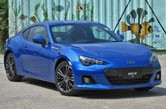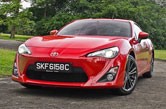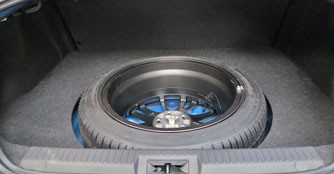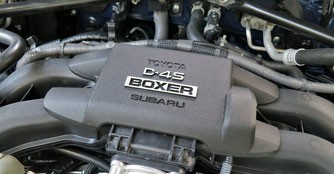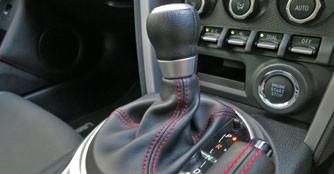Subaru BRZ 2.0 (A) Review
19 Sep 2012|34,596 views
The last time Subaru had a coupe in its line-up was with the GC two door Impress STI Type R which preceded the limited edition World Rally Car inspired 22B STI in the late 1990s. The latter remains the most desirable Subaru model ever in our opinion. Before the Impreza STI Type R coupe, Subaru had offered a couple of quirky looking coupes through the 1980s and early 1990s.
The first of these was the XT that was introduced in 1985. The XT was a quirky looking, wedged shaped two-door coupe with an aircraft cockpit inspired interior as well as airplane influenced design elements on its exterior. The XT was followed by another quirky looking two-door model that was introduced in 1991 - the SVX. The Giugiaro penned SVX is another unique looking Subaru two-door model. Its most distinguishing styling feature being its aircraft inspired 'glass-to-glass canopy' side window design.
Exterior
As you might be already aware of by now, Subaru has recently reintroduced a coupe into its line-up. following XT and SVX, the name of this coupe is yet another acronym - BRZ, which stands for Boxer-engine, Rear-wheel drive, Zenith. Unlike the XT and SVX, the BRZ hardly looks quirky and unusual. Subaru has after all, stayed away from quirky and strange these days.
In the BRZ's case though, it is because it is basically the same car as Toyota's 86. Both cars were born out of a partnership between Toyota and Subaru with the latter's Gunma factory responsible for production of both the BRZ and 86.
The first of these was the XT that was introduced in 1985. The XT was a quirky looking, wedged shaped two-door coupe with an aircraft cockpit inspired interior as well as airplane influenced design elements on its exterior. The XT was followed by another quirky looking two-door model that was introduced in 1991 - the SVX. The Giugiaro penned SVX is another unique looking Subaru two-door model. Its most distinguishing styling feature being its aircraft inspired 'glass-to-glass canopy' side window design.
Exterior
As you might be already aware of by now, Subaru has recently reintroduced a coupe into its line-up. following XT and SVX, the name of this coupe is yet another acronym - BRZ, which stands for Boxer-engine, Rear-wheel drive, Zenith. Unlike the XT and SVX, the BRZ hardly looks quirky and unusual. Subaru has after all, stayed away from quirky and strange these days.
In the BRZ's case though, it is because it is basically the same car as Toyota's 86. Both cars were born out of a partnership between Toyota and Subaru with the latter's Gunma factory responsible for production of both the BRZ and 86.
 |
Quite obviously then, the BRZ's styling differs little from the 86's, which means a wide, low slung two-door coupe body that helps to lower its overall CG and hence improve its dynamics and agility.
It is up front where the BRZ's styling differs most from the 86. While the BRZ's bumper air intake is hexagonal in shape, the 86's is shaped more like an inverted trapezoid. Also different from the Toyota's are the design of the dummy side vents on the front wings - the Toyota's not only look different but also features the '86' logo on either sides.
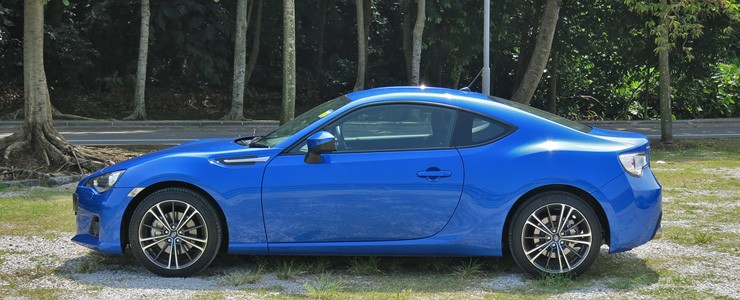 |
At the rear, a diffuser dominates the lower edge of the BRZ's bumper, with relatively large twin chrome-tipped exhaust pipes prominently protruding on each side. The clear tail lamps aren't exactly pretty in our opinion - it looks too aftermarket, especially when such tail lamp treatment are no longer in fashion like they did in the early 2000s. The BRZ's 17-inch alloy wheels are also similar to the 86's.
With only minor differences between the BRZ and 86 at the front, it is a matter of taste or individual preference on the better looker of the two. One thing the two cars totally are in common is their purposeful and low slung looks which do give them a sporty and muscular stance rather than being stunningly stylish. Those who find the looks a tad tame can always browse through the TRD or STI catalogue for bigger wheel options as well as aero kits.
Interior
The BRZ's interior is similar to the 86's bar, the seat upholstery and the logo on the steering wheel. Key aspect of the interior is the exceptionally low and well-judged driving position, which helps for fast and sporty driving. Other sporty touches inside the cabin include a compact steering wheel, an instrument cluster with the rev counter taking centre stage like in a Porsche with a shift light as well as an audible reminder, body hugging sports seats that are hugely supportive in the bends.
With only minor differences between the BRZ and 86 at the front, it is a matter of taste or individual preference on the better looker of the two. One thing the two cars totally are in common is their purposeful and low slung looks which do give them a sporty and muscular stance rather than being stunningly stylish. Those who find the looks a tad tame can always browse through the TRD or STI catalogue for bigger wheel options as well as aero kits.
Interior
The BRZ's interior is similar to the 86's bar, the seat upholstery and the logo on the steering wheel. Key aspect of the interior is the exceptionally low and well-judged driving position, which helps for fast and sporty driving. Other sporty touches inside the cabin include a compact steering wheel, an instrument cluster with the rev counter taking centre stage like in a Porsche with a shift light as well as an audible reminder, body hugging sports seats that are hugely supportive in the bends.
The rear seats are more 'token' items rather than proper, useable ones - an average-sized adult will have trouble finding enough any form of head or legroom. Moreover, the front seats don't slide and tilt forward enough to aid entry and exit to the rear. The boot is also a small affair and due to the full-sized spare, doesn't even come with a carpeted floor. On the upside, the rear seat backs can be folded down to extend the boot area further if needed.
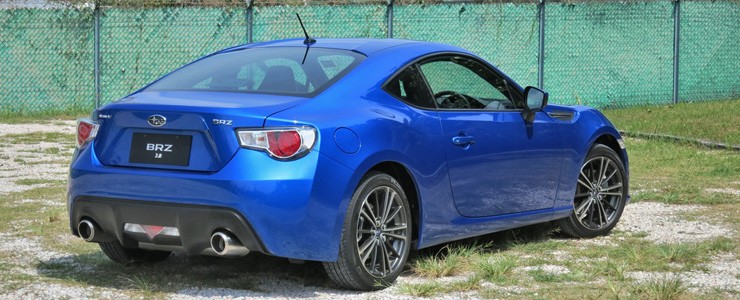 |
The Drive
Subaru's FA 2.0-litre boxer motor provides the power to the BRZ. The motor makes 200bhp at 7000rpm, which is sufficient for a sports coupe that weighs in at just 1253kg. When it comes to torque output though, the engine's peak pulling power of just 205Nm at a high 6400rpm to 6600rpm is hardly enough or exploitable, making the boxer motor lack tractability and flexibility at low to mid-range speeds. With this engine, you'd need to rev it all the way to its 7,500rpm redline to fully exploit its performance.
Toyota's input on the engine front comes in the form of its D-4S direct injection system that apparently significantly aids fuel economy. Like any direct injected equipped motors out there though, the BRZ's flat-four can be a tad noisy during idling. Speaking of noise, the engine doesn't make the flat-four off beat burble that Subaru's flat-four are well known for. Instead, the BRZ's soundtrack is dominated by a highly audible induction roar each time it is revved.
Two six-speed transmissions are available with the BRZ - a slick shifting manual and a more convenient torque converter based six-speed automatic. Obviously, the auto model, which we drove, doesn't deliver performance that is convincing as the manual transmission model's - the auto's quoted 0-100km/h time of 8.2 seconds is 0.6 seconds off the manual transmission model's pace. When left to its own devices, the gearbox has a habit of slurring its gear changes, which in turn dampens response. For the keener driver though, it's best to drive the auto in manual mode.
Subaru's FA 2.0-litre boxer motor provides the power to the BRZ. The motor makes 200bhp at 7000rpm, which is sufficient for a sports coupe that weighs in at just 1253kg. When it comes to torque output though, the engine's peak pulling power of just 205Nm at a high 6400rpm to 6600rpm is hardly enough or exploitable, making the boxer motor lack tractability and flexibility at low to mid-range speeds. With this engine, you'd need to rev it all the way to its 7,500rpm redline to fully exploit its performance.
Toyota's input on the engine front comes in the form of its D-4S direct injection system that apparently significantly aids fuel economy. Like any direct injected equipped motors out there though, the BRZ's flat-four can be a tad noisy during idling. Speaking of noise, the engine doesn't make the flat-four off beat burble that Subaru's flat-four are well known for. Instead, the BRZ's soundtrack is dominated by a highly audible induction roar each time it is revved.
Two six-speed transmissions are available with the BRZ - a slick shifting manual and a more convenient torque converter based six-speed automatic. Obviously, the auto model, which we drove, doesn't deliver performance that is convincing as the manual transmission model's - the auto's quoted 0-100km/h time of 8.2 seconds is 0.6 seconds off the manual transmission model's pace. When left to its own devices, the gearbox has a habit of slurring its gear changes, which in turn dampens response. For the keener driver though, it's best to drive the auto in manual mode.
When driven hard, the BRZ is wonderfully agile and eager to change directions via its accurate and razor sharp steering. Body control is faultless thanks in part to its low height and centre of gravity. On the other hand, the taut handling means a ride that is on the bumpy side, which can make the BRZ a tiring and draining car to drive over long cruises.
Conclusion
The BRZ and Toyota 86 marks a return of the relatively affordable Japanese sports coupes that were so popular back in the 1990s with models like the Honda Integra and the Nissan Silvia. Note that we wrote 'relatively affordable' rather than just 'affordable' because due to the current COE climate, the BRZ and the 86 are hardly affordable these days, which makes it a real pity for those in search of cheap thrills.
Both the BRZ and its Toyota 86 relative deliver fun in the bucket loads if they're driven hard and spiritedly. Price though is not on the BRZ's side - at almost $200k, most of its typical target audience will find it to be a rather expensive pill to swallow.
The last time Subaru had a coupe in its line-up was with the GC two door Impress STI Type R which preceded the limited edition World Rally Car inspired 22B STI in the late 1990s. The latter remains the most desirable Subaru model ever in our opinion. Before the Impreza STI Type R coupe, Subaru had offered a couple of quirky looking coupes through the 1980s and early 1990s.
The first of these was the XT that was introduced in 1985. The XT was a quirky looking, wedged shaped two-door coupe with an aircraft cockpit inspired interior as well as airplane influenced design elements on its exterior. The XT was followed by another quirky looking two-door model that was introduced in 1991 - the SVX. The Giugiaro penned SVX is another unique looking Subaru two-door model. Its most distinguishing styling feature being its aircraft inspired 'glass-to-glass canopy' side window design.
Exterior
As you might be already aware of by now, Subaru has recently reintroduced a coupe into its line-up. following XT and SVX, the name of this coupe is yet another acronym - BRZ, which stands for Boxer-engine, Rear-wheel drive, Zenith. Unlike the XT and SVX, the BRZ hardly looks quirky and unusual. Subaru has after all, stayed away from quirky and strange these days.
In the BRZ's case though, it is because it is basically the same car as Toyota's 86. Both cars were born out of a partnership between Toyota and Subaru with the latter's Gunma factory responsible for production of both the BRZ and 86.
The first of these was the XT that was introduced in 1985. The XT was a quirky looking, wedged shaped two-door coupe with an aircraft cockpit inspired interior as well as airplane influenced design elements on its exterior. The XT was followed by another quirky looking two-door model that was introduced in 1991 - the SVX. The Giugiaro penned SVX is another unique looking Subaru two-door model. Its most distinguishing styling feature being its aircraft inspired 'glass-to-glass canopy' side window design.
Exterior
As you might be already aware of by now, Subaru has recently reintroduced a coupe into its line-up. following XT and SVX, the name of this coupe is yet another acronym - BRZ, which stands for Boxer-engine, Rear-wheel drive, Zenith. Unlike the XT and SVX, the BRZ hardly looks quirky and unusual. Subaru has after all, stayed away from quirky and strange these days.
In the BRZ's case though, it is because it is basically the same car as Toyota's 86. Both cars were born out of a partnership between Toyota and Subaru with the latter's Gunma factory responsible for production of both the BRZ and 86.
Quite obviously then, the BRZ's styling differs little from the 86's, which means a wide, low slung two-door coupe body that helps to lower its overall CG and hence improve its dynamics and agility.
It is up front where the BRZ's styling differs most from the 86. While the BRZ's bumper air intake is hexagonal in shape, the 86's is shaped more like an inverted trapezoid. Also different from the Toyota's are the design of the dummy side vents on the front wings - the Toyota's not only look different but also features the '86' logo on either sides.
It is up front where the BRZ's styling differs most from the 86. While the BRZ's bumper air intake is hexagonal in shape, the 86's is shaped more like an inverted trapezoid. Also different from the Toyota's are the design of the dummy side vents on the front wings - the Toyota's not only look different but also features the '86' logo on either sides.
At the rear, a diffuser dominates the lower edge of the BRZ's bumper, with relatively large twin chrome-tipped exhaust pipes prominently protruding on each side. The clear tail lamps aren't exactly pretty in our opinion - it looks too aftermarket, especially when such tail lamp treatment are no longer in fashion like they did in the early 2000s. The BRZ's 17-inch alloy wheels are also similar to the 86's.
With only minor differences between the BRZ and 86 at the front, it is a matter of taste or individual preference on the better looker of the two. One thing the two cars totally are in common is their purposeful and low slung looks which do give them a sporty and muscular stance rather than being stunningly stylish. Those who find the looks a tad tame can always browse through the TRD or STI catalogue for bigger wheel options as well as aero kits.
Interior
The BRZ's interior is similar to the 86's bar, the seat upholstery and the logo on the steering wheel. Key aspect of the interior is the exceptionally low and well-judged driving position, which helps for fast and sporty driving. Other sporty touches inside the cabin include a compact steering wheel, an instrument cluster with the rev counter taking centre stage like in a Porsche with a shift light as well as an audible reminder, body hugging sports seats that are hugely supportive in the bends.
With only minor differences between the BRZ and 86 at the front, it is a matter of taste or individual preference on the better looker of the two. One thing the two cars totally are in common is their purposeful and low slung looks which do give them a sporty and muscular stance rather than being stunningly stylish. Those who find the looks a tad tame can always browse through the TRD or STI catalogue for bigger wheel options as well as aero kits.
Interior
The BRZ's interior is similar to the 86's bar, the seat upholstery and the logo on the steering wheel. Key aspect of the interior is the exceptionally low and well-judged driving position, which helps for fast and sporty driving. Other sporty touches inside the cabin include a compact steering wheel, an instrument cluster with the rev counter taking centre stage like in a Porsche with a shift light as well as an audible reminder, body hugging sports seats that are hugely supportive in the bends.
The rear seats are more 'token' items rather than proper, useable ones - an average-sized adult will have trouble finding enough any form of head or legroom. Moreover, the front seats don't slide and tilt forward enough to aid entry and exit to the rear. The boot is also a small affair and due to the full-sized spare, doesn't even come with a carpeted floor. On the upside, the rear seat backs can be folded down to extend the boot area further if needed.
The Drive
Subaru's FA 2.0-litre boxer motor provides the power to the BRZ. The motor makes 200bhp at 7000rpm, which is sufficient for a sports coupe that weighs in at just 1253kg. When it comes to torque output though, the engine's peak pulling power of just 205Nm at a high 6400rpm to 6600rpm is hardly enough or exploitable, making the boxer motor lack tractability and flexibility at low to mid-range speeds. With this engine, you'd need to rev it all the way to its 7,500rpm redline to fully exploit its performance.
Toyota's input on the engine front comes in the form of its D-4S direct injection system that apparently significantly aids fuel economy. Like any direct injected equipped motors out there though, the BRZ's flat-four can be a tad noisy during idling. Speaking of noise, the engine doesn't make the flat-four off beat burble that Subaru's flat-four are well known for. Instead, the BRZ's soundtrack is dominated by a highly audible induction roar each time it is revved.
Two six-speed transmissions are available with the BRZ - a slick shifting manual and a more convenient torque converter based six-speed automatic. Obviously, the auto model, which we drove, doesn't deliver performance that is convincing as the manual transmission model's - the auto's quoted 0-100km/h time of 8.2 seconds is 0.6 seconds off the manual transmission model's pace. When left to its own devices, the gearbox has a habit of slurring its gear changes, which in turn dampens response. For the keener driver though, it's best to drive the auto in manual mode.
Subaru's FA 2.0-litre boxer motor provides the power to the BRZ. The motor makes 200bhp at 7000rpm, which is sufficient for a sports coupe that weighs in at just 1253kg. When it comes to torque output though, the engine's peak pulling power of just 205Nm at a high 6400rpm to 6600rpm is hardly enough or exploitable, making the boxer motor lack tractability and flexibility at low to mid-range speeds. With this engine, you'd need to rev it all the way to its 7,500rpm redline to fully exploit its performance.
Toyota's input on the engine front comes in the form of its D-4S direct injection system that apparently significantly aids fuel economy. Like any direct injected equipped motors out there though, the BRZ's flat-four can be a tad noisy during idling. Speaking of noise, the engine doesn't make the flat-four off beat burble that Subaru's flat-four are well known for. Instead, the BRZ's soundtrack is dominated by a highly audible induction roar each time it is revved.
Two six-speed transmissions are available with the BRZ - a slick shifting manual and a more convenient torque converter based six-speed automatic. Obviously, the auto model, which we drove, doesn't deliver performance that is convincing as the manual transmission model's - the auto's quoted 0-100km/h time of 8.2 seconds is 0.6 seconds off the manual transmission model's pace. When left to its own devices, the gearbox has a habit of slurring its gear changes, which in turn dampens response. For the keener driver though, it's best to drive the auto in manual mode.
When driven hard, the BRZ is wonderfully agile and eager to change directions via its accurate and razor sharp steering. Body control is faultless thanks in part to its low height and centre of gravity. On the other hand, the taut handling means a ride that is on the bumpy side, which can make the BRZ a tiring and draining car to drive over long cruises.
Conclusion
The BRZ and Toyota 86 marks a return of the relatively affordable Japanese sports coupes that were so popular back in the 1990s with models like the Honda Integra and the Nissan Silvia. Note that we wrote 'relatively affordable' rather than just 'affordable' because due to the current COE climate, the BRZ and the 86 are hardly affordable these days, which makes it a real pity for those in search of cheap thrills.
Both the BRZ and its Toyota 86 relative deliver fun in the bucket loads if they're driven hard and spiritedly. Price though is not on the BRZ's side - at almost $200k, most of its typical target audience will find it to be a rather expensive pill to swallow.
Conclusion
The BRZ and Toyota 86 marks a return of the relatively affordable Japanese sports coupes that were so popular back in the 1990s with models like the Honda Integra and the Nissan Silvia. Note that we wrote 'relatively affordable' rather than just 'affordable' because due to the current COE climate, the BRZ and the 86 are hardly affordable these days, which makes it a real pity for those in search of cheap thrills.
Both the BRZ and its Toyota 86 relative deliver fun in the bucket loads if they're driven hard and spiritedly. Price though is not on the BRZ's side - at almost $200k, most of its typical target audience will find it to be a rather expensive pill to swallow.
Car Information
Subaru BRZ 2.0 (M)
CAT B|Petrol|12.8km/L
Horsepower
149kW (200 bhp)
Torque
205 Nm
Acceleration
7.6sec (0-100km /hr)
This model is no longer being sold by local distributor
All Used Subaru BRZThank You For Your Subscription.





















